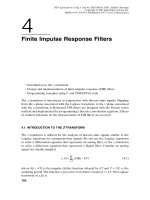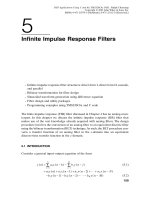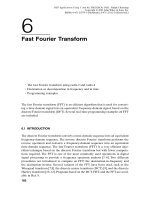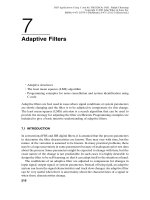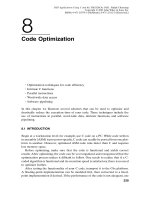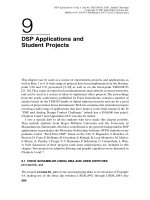Al2O3:C and Al2O3:C,Mg optically stimulated luminescence 2D dosimetry applied to magnetic resonance guided radiotherapy
Bạn đang xem bản rút gọn của tài liệu. Xem và tải ngay bản đầy đủ của tài liệu tại đây (5.26 MB, 10 trang )
Radiation Measurements 138 (2020) 106439
Contents lists available at ScienceDirect
Radiation Measurements
journal homepage: />
Al2O3:C and Al2O3:C,Mg optically stimulated luminescence 2D dosimetry
applied to magnetic resonance guided radiotherapy
N. Shrestha a, E.G. Yukihara a, c, *, Davide Cusumano b, Lorenzo Placidi b
a
Physics Department, Oklahoma State University, Stillwater, OK, United States
Fondazione Policlinico Universitario ‘‘A. Gemelli’’ IRCCS, UOC Radioterapia Oncologica, Dipartimento di Diagnostica per Immagini, Radioterapia Oncologica Ed
Ematologia, Roma, Italy
c
Department of Radiation Safety and Security, Paul Scherrer Institute, Villigen, Switzerland
b
A R T I C L E I N F O
A B S T R A C T
Keywords:
Optically stimulated luminescence
2D dosimetry
Aluminum-oxide
Magnetic resonance guided radiation therapy
The objective of this work is to demonstrate the potential application of Al2O3:C and Al2O3:C,Mg optically
stimulated luminescence (OSL) films for 2D dosimetry in magnetic resonance guided radiotherapy (MRgRT), a
modality which combines two dosimetric challenges: small field dosimetry and dosimetry in the presence of a
magnetic field. To achieve that, prototype Al2O3:C and Al2O3:C,Mg OSL films produced by Landauer (Glenwood,
IL, USA) were characterized using a MRIdian system (ViewRay Inc., Mountain View, California, USA). The
system was initially equipped with three 60Co heads on a ring gantry combined with a 0.35 T split-magnet MRI
system and later upgraded with a 6 MV Flattening Filter-Free (FFF) linear accelerator, with a fixed dose rate of
600 MU/min. The dosimetric properties of the film material (Al2O3:C) in the magnetic field were first tested by
irradiating samples of 7 mm in diameter read using a Risø TL/OSL automated reader for high precision. OSL films
(Al2O3:C and Al2O3:C,Mg) were then tested at different doses and for two different intensity modulated radiation
therapy (IMRT) treatment plans, for which the gamma analysis was performed using the 2D dose information
obtained by readout of the films using a laser-scanning OSL reader. The results using the “point-dosimeter”
samples showed deviations <4% with the delivered dose and variations within the same package of <4%
(standard deviation of the data). The gamma analysis for IMRT plans showed pass rates >95% with a 3% - 3 mm
criteria (>84% with a 2% - 2 mm criteria), with the failure typically happening in the edges of the film, not in the
central high dose region. The results did not show any clear influence of the magnetic field and demonstrate the
feasibility of Al2O3:C and Al2O3:C,Mg OSL dosimeters for 2D dosimetry in MRgRT.
1. Introduction
Recent developments towards real-time image guided radiotherapy
hybrid devices have led to the combination of a magnetic resonance
imaging (MRI) scanner with a radiotherapy unit, such as a linear
accelerator or 60Co sources (Fallone et al., 2009; Jaffray et al., 2010,
2014; Lagendijk et al., 2014; Mutic and Dempsey, 2014). Such systems
provide real-time imaging during the patient treatment, reducing un
certainties in the patient positioning and target localization and poten
tially improving the precision of the therapy.
Nevertheless, the Lorentz force alters the trajectory of the secondary
electrons in the air cavities, which affects the detector response of
ionization chambers according to the magnetic field strength and the
orientation of the chamber (Meijsing et al., 2009; Reynolds et al., 2013;
Smit et al., 2013; O’Brien et al., 2017). Other solid-state detectors such
as diamond detectors, plastic scintillators and radiochromic films (Gaf
chromic EBT2 and EBT3, Ashland Inc.) are also affected by the magnetic
field (Stefanowicz et al., 2013; Reynolds et al., 2014; Reynoso et al.,
2016; Cusumano et al., 2018; Delfs et al., 2018; O’Brien et al., 2018).
Luminescence detectors are now well accepted in medical dosimetry
(Kry et al., 2020) and considered promising candidates for dosimetry in
magnetic field (Jelen and Begg, 2019). Thermoluminescence detectors
(TLDs) were found to show <1% field dependence up to 1.5 T transverse
field (Wang et al., 2016; Wen et al., 2016; Steinmann et al., 2019).
Spindeldreier et al. (2017) observed a relatively small decrease in
response of Al2O3 optically stimulated luminescence detectors (OSLDs)
with increasing magnetic field (− 1.3%/T) and no angular dependence.
In addition, various luminescence techniques and materials have been
* Corresponding author. Department of Radiation Safety and Security, Paul Scherrer Institute, 111 Forschungsstrasse, 5232, Villigen, Switzerland.
E-mail address: (E.G. Yukihara).
/>Received 3 July 2020; Accepted 28 July 2020
Available online 1 August 2020
1350-4487/© 2020 The Authors.
Published
( />
by
Elsevier
Ltd.
This
is
an
open
access
article
under
the
CC
BY-NC-ND
license
N. Shrestha et al.
Radiation Measurements 138 (2020) 106439
Fig. 1. Schematics of the 2D OSL laser scanning dosimetry system.
Fig. 2. Irradiation configuration of the OSLD “points detectors” (setup A and B) or films (setup A).
recently investigated for potential 2D dosimetry applications in medi
cine (Li et al., 2014; Crijns et al., 2017; Souza et al., 2017; Nascimento
et al., 2019; Sądel et al., 2020a, 2020b).
Al2O3:C are commercially available TL and OSL dosimeters with high
sensitivity to radiation (Akselrod and Kortov, 1990), linear dose
response (Jursinic, 2007; Viamonte et al., 2008; Reft, 2009), wide dy
namic dose range (Akselrod and McKeever, 1999), potential dosimetric
precision of <1% (Yukihara et al., 2005), minimal dark fading (Via
monte et al., 2008), low energy dependence of ±1% in MV X-ray beams
(Viamonte et al., 2008), dose rate independent (Jursinic, 2007), and
small angular dependence for MV X-ray beam (Jursinic, 2007). A review
on the OSL technique and the application of Al2O3:C dosimeters in
medicine can be found in Yukihara and McKeever (2008) and in a recent
report of American Association of Physicists in Medicine Task Group 191
(Kry et al., 2020). In contrast to ionization chambers, the OSL detectors
themselves (without casing or holders) do not have air cavities and are
expected not to be influenced by magnetic fields.
Until recently, however, OSLDs were limited to point dosimetry. The
slow luminescence of the F-center emission (35 ms lifetime), the main
luminescence center in this material, prevented its use in 2D dosimetry
using laser-scanning techniques, the imaging modality used in computed
radiography. This situation changed with the development of a correc
tion algorithm for Al2O3 films (Yukihara and Ahmed, 2015), which led
to the development of laser-scanning 2D dosimetry based on Al2O3:C or
Al2O3:C,Mg OSL films (Ahmed et al., 2014, 2017). Initial tests with 6 MV
X-ray beams using Al2O3 films show that the films have low background
(~mGy), linear response, wide dynamic range (4–5 orders), good spatial
resolution (~1 mm), and potential dose uncertainty within 2% (Ahmed
et al., 2014). An additional advantage of OSL films with respect to
radiochromic films is their potential re-usability, since an inherent
property of the OSL is that it can be bleached by light exposure
(bleaching); e.g. see Crijns et al. (2017).
The objective of this work is to evaluate the performance of newly
developed Al2O3:C and Al2O3:C,Mg OSL films for application in 2D
dosimetry in the presence of a 0.35 T magnetic field. To achieve that, a
MRidian system (ViewRay Inc., Mountain View, California, USA) was
used to investigate the response of OSL films samples of 7 mm in
diameter, read using an automated Risø OSL reader (DTU Nutech,
Denmark) for high precision, and the response of OSL films (5.0 cm ×
5.0 cm) read using a laser-scanning OSL reader. IMRT plans were also
2
N. Shrestha et al.
Radiation Measurements 138 (2020) 106439
Fig. 3. OSL response for irradiations using the MRIdian system. Each data point
is the average of 5 samples, and the error bars (barely visible) represent the
standard deviation of the mean of the samples. The OSL response is the OSL
signal converted into the Risø beta irradiation time (s) required to produce a
signal of the same intensity using an “internal calibration” (see Section 2.1).
Fig. 5. Image of an Al2O3:C film (5.0 cm × 5.0 cm) irradiated with a total dose
of 2.0 Gy (depth: 5.0 cm, field size: 10.5 cm × 10.5 cm, SSD: 100.0 cm).
grain size (<15 μm median) (Ahmed et al., 2016b).
For tests requiring higher precision, OSL film samples of ~7 mm
diameter were prepared from the same Al2O3:C OSLD films (Lot. #
31218Y2N) by punching out small round pieces. The detectors were
packaged (five detectors per package) with black electric tape to protect
them from light after irradiation, using a paper to protect the detectors
from the tape glue.
The small OSLD film samples were read using a Risø TL/OSL-DA-20
reader (DTU Nutech, Denmark), which can achieve precision <1% per
readout through automatic individual calibration of the detectors
(Yukihara et al., 2005), but no 2D information is obtained. The reader is
equipped with a 1.48 GBq 90Sr/90Sr beta source. The samples were
stimulated with green LEDs (broad band centered at 525 nm, irradiance
of ~40 mW/cm2 at the sample position) and the light was detected using
an ET Enterprises PMD9107Q-AP-TTL photomultiplier tube (PMT).
Hoya U-340 filters (Hoya Corporation, 5 mm thickness) and a neutral
density filter (Edmund Optics UV/VIS ND 1.0 OD, serial number EO
47207) were used in front of the PMT. The reader is equipped with a
software-controlled Detection and Stimulation Head (DASH). The reader
is also equipped with a Photon Timer attachment (Time-Correlated
Single Photon Counter board, PicoQuant TimeHarp 260) for lifetime and
time-resolved measurements. To avoid detection of the UV emission
band of Al2O3:C, the samples were measured using the pulsed OSL
(POSL) mode, the LED being pulsed for 1 ms every 2 ms and the OSL
being detected only when the LED is off. The samples were stimulated
for 240 s and the total counts (minus background) were used as the OSL
signal.
For the readout of the “point detectors”, the high-precision meth
odology described by Yukihara et al. (2005) was used. After the first
readout to obtain the signal S, the detectors were irradiated with the
Risø beta source for 300 s and read again to obtain a reference signal SR.
The ratio S/SR was then plotted against the beta irradiation time to
obtain an “internal calibration” curve. In this procedure, the OSL signal
is converted using the “internal calibration” into the beta irradiation
time required to produce a signal of the same intensity. Using detectors
irradiated with a known dose, the dose rate of the beta source can be
obtained, from which the dose for detectors irradiated with an unknown
dose can be determined. This procedure has the advantage of elimi
nating any variation due to detectors sensitivity and mass, enabling a
precision <1% per detector in a convenient way (Yukihara et al., 2005).
For 2D dose measurements, the OSLD films were cut into 5.0 cm ×
5.0 cm or 10.0 cm × 10.0 cm pieces and bleached using fluorescent
lamps filtered with a Schott GG-495 filter (Schott AG). The films were
then packaged in light absorbing adhesive flock papers, as described in
Fig. 4. OSL response irradiated at the center of a cylindrical phantom, as a
function of the gantry angle, the phantom being rotated to keep the irradiation
perpendicular to the dosimeters’ plane. Each data point is the average of five
samples and the error bars represent the standard deviation of the mean of the
five samples.
delivered to OSL films (10.0 cm × 10.0 cm) and the measured dose
distributions were compared with those calculated using a dedicated
treatment planning system (TPS) and the gamma analysis (Low et al.,
1998; Low and Dempsey, 2003). The dosimetric properties of Al2O3:C
are well-established – see Kry et al. (2020) and references therein – and
the 2D dosimetry capabilities of the Al2O3 films were already reported
(Ahmed et al., 2016b, 2017). Therefore, the present work is concerned
primarily with possible effects of the presence of the magnetic field on
the results.
2. Materials and methods
2.1. Detectors and readout
The Al2O3:C OSLD films (Lot. # 31218Y2N) and Al2O3:C,Mg OSLD
films (Lot. # 41128Y2N) consist of a (47 ± 3) μm thick layer of Al2O3
powder mixed with binder and deposited on a 75 μm thick polyester
substrate. The powder used in the Al2O3:C films is made of the same
material used in Luxel™ and InLight™ dosimetry systems (Landauer,
Glenwood, IL, USA), but produced using material ground to smaller
3
N. Shrestha et al.
Radiation Measurements 138 (2020) 106439
Fig. 6. Dose response using the MRI
dian system with static magnetic field
of 0.35 T (depth: 5.0 cm, field size:
10.5 cm × 10.5 cm, SSD: 100 cm) for
5.0 cm × 5.0 cm films of Al2O3:C and
Al2O3:C,Mg. (a–b) Signal profiles
(average of 40 rows spanning 1.0 cm)
in both x and y-directions for all
doses; (c) dose response curve ob
tained using the OSL films where each
data point is the average of two films
signal calculated over 2.0 cm × 2.0
cm (~80 pixels × 80 pixels) around
the central axis. The fitted functions
are D = a(1 − e− bS ) with parameters a
= (23.5 ± 1.1) Gy and b = (2.18 ±
0.12) × 10− 4 count− 1 for Al2O3:C and
a = (42.6 ± 5.4) Gy and b = (1.77 ±
0.25) × 10− 4 count− 1 for Al2O3:C,Mg.
Ahmed et al. (2016b).
The OSLD films were read using a custom-built laser-canning 2D OSL
reader illustrated in Fig. 1 (Ahmed et al., 2014, 2016a, 2016b, 2017;
Yukihara and Ahmed, 2015). The reader consists of a 532 nm
diode-pumped solid-state (DPSS) laser (model GMLN-532-100FED, 100
mW output power, Lasermate Group, Inc.) for stimulation and a 2D
galvanometer mirror system (model GVS002, Thorlabs, Inc.) to reflect
and scan the laser into the OSL film placed on top of a Schott GG-495
long-pass filter (15.0 cm × 15.0 cm × 3.5 mm, Schott Glass Corpora
tion). A Hoya U-340 band-pass filter (15.0 cm × 15.0 cm × 3.0 mm
thick, Hoya Corporation) is placed on top of the film to keep the film flat.
An additional 5.0-mm thick Hoya U-340 filter is placed in front of the
PMT (51 mm diameter, 9235QA, Electron Tubes Inc.) to block any laser
light reaching the PMT. The signal recorded by the PMT is amplified by a
pre-amplifier (model SR-445, Stanford Research Systems) and digitized
using a multichannel scaler (model SR-430, Stanford Research). The
laser power is constantly monitored with a photodiode during scanning
(model DET10A, Thorlabs, Inc.). The image reconstruction algorithm
includes corrections for pixel bleeding (Yukihara and Ahmed, 2015),
PMT dead time, light collection efficiency, and geometrical distortions
(Ahmed et al., 2016a).
field force lines are perpendicular to the radiation beam axis. Although
the photon spectra of the 60Co and 6 MV FFF linac are different, here
only relative results are presented and, therefore, this should not affect
the results. A conventional LINAC (True Beam Edge, 6 MV FFF) was also
used for additional tests.
The irradiations were carried out placing the detectors in two setups
(Fig. 2). In Setup A (Fig. 2a), the detectors (packages containing “point
detectors” or films) were placed in between 30.0 cm × 30.0 cm Solid
Water (Solid Water, Gammex RMI, iddleton, WI 53562, USA) slabs at a
depth of 1.5 cm with 10.0 cm material for backscattering and irradiated
at a source-to-surface distance (SSD) = 85.0 cm, source-to-axis distance
(SAD) = 90.0 cm, field size 9.96 cm × 9.96 cm, and 600 MU/min. Setup
A was also positioned rotated ±90◦ , with the gantry rotated accordingly
to maintain the irradiation direction with respect to the detector
orientation, therefore changing only the orientation of the detectors
with respect to the magnetic field lines. Since cylindrical symmetry of
the equipment is assumed, the irradiations should be identical.
In setup B (Fig. 2b), packages containing points detectors were place
in a cylindrical phantom of 7.0 cm diameter by 25.5 cm length. The
cylinder itself was placed in a 5.0 mm thick PMMA shell to allow the
rotation of the cylinder. The detectors were placed at different angles
with respect to the vertical (0◦ ), the gantry being rotated accordingly so
that the irradiation is always perpendicular to the dosimeter plane, as
shown in Fig. 2. The beam field size was large enough to guarantee a
dose uniformity better than 1% within the dosimeter package. Again,
the objective here was to maintain the orientation of the irradiation with
respect to the dosimeters and only change the dosimeter orientation
with respect to the magnetic field lines.
Irradiations with two IMRT plans were also performed using a setup
similar to Setup A, but with the OSL films positioned at a depth of 5.0 cm
and with 10.0 cm of material for backscattering.
2.2. Irradiations
The irradiations in magnetic field were performed using a MRIdian
system at Fondazione Policlinico Universitario Agostino Gemelli (Rome,
Italy). The system was initially equipped with three 60Co heads on a ring
gantry combined with a 0.35 T split-magnet MRI system (Mutic and
Dempsey, 2014) and was later upgraded with a 6 MV Flattening
Filter-Free (FFF) linac with a fixed dose rate of 600 monitoring units
(MU) per minute replacing the 60Co sources. In this system the magnetic
4
N. Shrestha et al.
Radiation Measurements 138 (2020) 106439
Fig. 7. (a) Images of the IMRT plan I and the resulting OSL images for (b) Al2O3:C and (c) Al2O3:C,Mg films irradiated on a phantom (Fig. 2a) at 5.0 cm.
2.3. Gamma analysis
image was binned into 4 pixels × 4 pixels to convert the pixel size into
1.0 mm × 1.0 mm. A 5 pixels × 5 pixel Wiener filter (Gibbs, 2011)
implemented in Mathematica (Wolfram Research) was applied to further
smooth the image. The points with dose <10% of the maximum dose
were excluded from the analysis.
The gamma analysis algorithm used here is the same described in
Low et al. (1998). The spatial resolution of the calculated image was
1.25 mm and was interpolated to 1.0 mm. In the case of OSL images the
5
N. Shrestha et al.
Radiation Measurements 138 (2020) 106439
Fig. 8. Gamma analysis results for the IMRT plan I (data from Fig. 7) for (a) Al2O3:C and (b) Al2O3:C,Mg films obtained using 3% - 3 mm criteria. Red pixel indicates
pixel with points failing the gamma criteria. Comparison of central dose profiles of images of IMRT plan with Al2O3:C and Al2O3:C,Mg films the (c) x-axis and (d) yaxis. (For interpretation of the references to colour in this figure legend, the reader is referred to the Web version of this article.)
3. Results and discussion
Section 2.2), but the results were identical, with standard deviation
within the packages of 2.4–2.6% in average. This suggests that the
increased standard deviation may be related to other influencing factors
not identified (sample, packaging, irradiation conditions) and not the
influence of magnetic field. The reproducibility of S/SR ratios obtained
for the internal calibration (see Section 2.1), when all detectors are
irradiated using only the Risø beta source, was <0.7%, showing that the
reader itself does not seem to be the cause for the increased uncertainty.
Measurements were made with OSLD packages placed at 0.5 cm and
at 1.5 cm to determine the feasibility of using OSLDs as in-vivo dosim
eters. The irradiations were performed delivering a dose of 2.0 Gy at 1.5
cm. The results were (1.79 ± 0.03) Gy at 0.5 cm and (1.99 ± 0.03) Gy at
1.5 cm. The results show a good agreement with the dose delivered at
1.5 cm, within 1.0%. The reduced surface dose is, of course, due to the
lack of build-up. The uncertainty is the standard deviation of the mean
value based on the 5 detectors; the standard deviation of the data were
4.0% and 3.0% respectively. This result shows the potential of using the
OSLDs as in-vivo dosimeters in MRgRT.
The irradiation with OSLD packages at 1.5 cm was repeated once in
setup A (Fig. 2) and then rotating setup A and the gantry to ±90◦ ,
keeping the delivered dose 2.0 Gy. The results obtained were (1.94 ±
0.02) Gy at 0◦ , (2.00 ± 0.03) Gy at +90◦ and (2.01 ± 0.03) Gy at − 90◦ .
The data at zero degrees (− 3.1% discrepancy with delivered dose)
provides an idea of the reproducibility of the irradiation and detector
positioning. Nevertheless, the data at ±90◦ show good agreement with
the delivered dose and indicates no dependence with the different
positioning of the OSLDs with respect to the field lines. The standard
3.1. Tests with “point” detectors
The linearity of the Al2O3:C film response in the presence of magnetic
field was checked by irradiating packages containing the “points de
tector” samples of the OSLD films with six different doses from 0.5 Gy to
10 (5 detectors for each dose) using the MRIdian linac system with a
static magnetic field of 0.35 T using a field size of 9.96 cm × 9.96 cm at
1.5 cm depth. The samples were then read out using the Risø reader as
described in Section 2.1.
Fig. 3 shows a plot of the OSL response, which is the OSL signal
converted into the Risø beta source irradiation time (s) required to
obtain a signal of the same intensity, as a function of the dose delivered
by the MRIdian system. The response of the film material was observed
to be linear and the dose rate of the Risø source was then estimated to be
48.5 mGy/s. Although the dose response of Al2O3:C is known to become
supralinear after a few grays, this is not seen here because the use of the
S/SR method, possible with the Risø reader, eliminates this effect
(Yukihara et al., 2005). For the film, this will not be possible, and the
OSL signal will be expressed in PMT counts.
The standard deviation of the data for the five detectors was in
average 2.5%, indicating the expected uncertainty for each detector due
to the readout procedure only. This value is larger than the 0.7% pre
viously reported for 50 detectors irradiated with a Varian linear accel
erator (Yukihara et al., 2005). Identical irradiations were repeated in
parallel using a conventional LINAC and the ViewRay LINAC (see
6
N. Shrestha et al.
Radiation Measurements 138 (2020) 106439
Fig. 9. (a) Images of the IMRT plan II and the resulting OSL images for (b) Al2O3:C and (c) Al2O3:C,Mg films irradiated on a phantom (Fig. 2a) at 5.0 cm.
deviation of the data was in average 3.2%.
A final test was performed irradiating the OSLD packages in the
center of a cylindrical phantom (Fig. 2b). In this setup, different irra
diations were performed positioning the cylindrical phantom and the
gantry at angles of 0◦ , 45◦ , 90◦ , 270◦ , 315◦ from the vertical (0◦ ),
keeping the irradiation perpendicular to the detector plane, as shown in
Fig. 2b. The plan was calculated to deliver a dose of 2 Gy at the detector
plane.
Fig. 4 shows the response of the OSLDs as a function of the phantom/
gantry angle. In this experiment the measured dose was 2% higher than
the given dose (2.0 Gy) at 0◦ , but 3% higher than the give dose at 90◦
and ~4% at 270◦ . These discrepancies may be due to the setup geom
etry. The standard deviation of the data was in average 3.1%, not higher
than the irradiations in setup A, indicating a relatively uniform irradi
ation field. Although this discrepancy cannot be explained at the
moment, we can see in Fig. 4 that the difference with respect to the mean
measured dose is only ±2%.
10 Gy. Fig. 5 shows an image of the Al2O3:C film irradiated with a total
delivered dose of 2.0 Gy. The low dose at the edge of the films indicates
the limit of the OSL films themselves.
To compare the image uniformity for two films at different doses, we
calculated the signal profiles (average of 1.0 cm) at the center of the
image in both x and y axes. The dose response curve was calculated
using the average signal over a central region of interest (ROI) 2.0 cm ×
2.0 cm (80 pixels × 80 pixels). Fig. 6a and b show two overlapping signal
profiles for each dose calculated in perpendicular directions (x and y
directions). As can be seen the x and y-profiles overlap at any dose level.
These results demonstrate no influence of the magnetic field in the
determination of dose homogeneity of the field.
Fig. 6c shows the OSLD film response versus delivered dose for both
Al2O3:C and Al2O3:C,Mg films. The dose-signal relationship was fitted
with the function D = a(1 − e− bS ). This function is not physical in the
sense that it does not saturate with dose, but similar functions were
shown to describe the supralinearity of the OSL of Al2O3:C in the limited
dose range investigated here (Ahmed et al., 2016b). The Al2O3:C film
has a response ~40% higher than the Al2O3:C,Mg film, but Al2O3:C,Mg
films show a better (~50%) signal-to-noise ratio (SNR = S/3σ). This is
due to the smaller correction required for pixel bleeding for the Al2O3:C,
Mg film in comparison with the Al2O3:C film. The OSLD films also show
the onset of supralinearity for doses above a few grays, as it is know for
Al2O3:C (Kry et al., 2020). These aspects were already reported before
3.2. Tests with OSLD films
The dose response for Al2O3:C and Al2O3:C,Mg films were deter
mined using the MRgRT system with 60Co as the radiation source. The
5.0 cm × 5.0 cm OSLD films were irradiated in a phantom (Fig. 2a) with
10.5 cm × 10.5 cm flat field at a depth of 5.0 cm for doses from 0.1 Gy to
7
N. Shrestha et al.
Radiation Measurements 138 (2020) 106439
Fig. 10. Gamma analysis results for the IMRT plan II (data from Fig. 9) for (a) Al2O3:C and (b) Al2O3:C,Mg films obtained using 3% - 3 mm criteria. Red pixel
indicates pixel with points failing the gamma criteria. Comparison of central dose profiles of images of IMRT plan with Al2O3:C and Al2O3:C,Mg films for the (c) x-axis
and (d) y-axis. (For interpretation of the references to colour in this figure legend, the reader is referred to the Web version of this article.)
both Al2O3:C (Fig. 8a) and Al2O3:C,Mg films (Fig. 8b). The high dose
regions pass the gamma analysis, whereas the region that fails the
criteria are low dose regions with high dose gradient.Fig. 8 also shows
the dose profiles at the center of the Al2O3:C (Fig. 8c) and Al2O3:C,Mg
(Fig. 8d) films and IMRT plans. The OSL dose profiles from both mate
rials agree well with each other and with the TPS.
Fig. 9 shows similar results for the IMRT plan II. The plan shown in
Fig. 9a was generated by three 3.15 × 3.15 cm2 fields, with a gantry
angle of 340◦ , 0◦ and 20◦ . The dose calculation was performed by a
Monte Carlo algorithm (ViewRay Inc., Mountain View, California, USA)
with dose grid resolution of 0.1 cm. Fig. 10 shows again the gamma
analysis for a criteria of 3% and 3 mm and the dose profiles for both
Al2O3:C and Al2O3:C,Mg films. The results are essentially identical to
those obtained for the IMRT Plan I.
Table 1 summarizes the gamma analysis for the two treatment plans,
for both Al2O3:C and Al2O3:C,Mg films. Additional results are included
for a 2% - 2 mm pass criteria. The results show that a gamma criteria of
3% - 3 mm and 2% - 2 mm results in passing rate of 98% and 95%
respectively for both film types irradiated with IMRT plan I. For IMRT
plan II the gamma criteria of 3% - 3 mm show a passing rate of ~95–97%
and gamma criteria of 2% - 2 mm show a passing rate of 84–91%
depending on the film. In this analysis the doses <10% of the maximum
dose were excluded from the calculation.
The gamma analysis failures occur typically on the border of the OSL
images, which is also the region where the image reconstruction
correction factors are the largest (Ahmed et al., 2016a). Because of the
design of the laser-scanning reader (Fig. 1), the light collection
Table 1
Summary of gamma analysis for the IMRT Plans I and II using Al2O3:C and
Al2O3:C,Mg films.
Material
Al2O3:C
Al2O3:C,Mg
Plan I
Plan II
3% - 3 mm
2% - 2 mm
3% - 3 mm
2% - 2 mm
98%
98%
95%
95%
97%
95%
91%
84%
(Ahmed et al., 2016b) and here we only note that the magnetic field did
not influence the results.
Al2O3:C and Al2O3:C,Mg OSLD films (10.0 cm × 10.0 cm) were
irradiated on a phantom (Fig. 2a) with two different treatment plans
using the MRIdian system at a depth of 5.0 cm. The films were read out
using the laser-scanning 2D dosimetry reader and the dose was calcu
lated for each pixel using the calibration curve from Fig. 6c.
Fig. 7 shows the TPS dose map of the IMRT plan I (Fig. 7a) and the
doses measured using the Al2O3:C films (Fig. 7b) and the Al2O3:C,Mg
films (Fig. 7c). The plan shown in Fig. 7a was generated by nine stepand-shoot IMRT fields, with an equal angular distance of 40◦ , with a
total of 72 modulated segments. The dose distribution was normalized to
deliver 4 Gy to 50% of the STAR-shaped target. The dose calculation was
performed by a Monte Carlo algorithm (ViewRay Inc., Mountain View,
California, USA) with dose grid resolution of 0.1 cm. The OSL 2D dose
map shows a good agreement with the TPS.
Fig. 8 shows the gamma analysis for a criteria of 3% and 3 mm for
8
N. Shrestha et al.
Radiation Measurements 138 (2020) 106439
efficiency drops radially from the center of the image. Nevertheless, this
is a feature of the design of our experimental reader. Typical
laser-scanning readers used in computed radiography capture the light
using light guides from the entire length of the film, therefore,
improving the collection efficiency from the borders of the film (Leblans
et al., 2011).
The gamma analysis studies show that OSL films show good agree
ment with the TPS data and no effect of the magnetic field on the OSL
response was observed in the current experimental conditions.
Dr. Cusumano, Dr. Placidi report personal fees due to speaker hono
rarium agreement from ViewRay, outside the submitted work.
Acknowledgements
The Risø TL/OSL-DA-20 reader (DTU Nutech, Denmark) was ac
quired with partial support from the Swiss National Science Foundation
(R’Equip project 206021_177028). The films and reader used in this
study were originally part of a project funded by Landauer (Glenwood,
IL, USA); no funding was provided for the specific studies reported here.
4. Conclusions and future developments
References
The tests using samples of Al2O3:C OSLD films (“point detectors”)
and Al2O3:C and Al2O3:C,Mg OSLD films did not show evidence of in
fluence of the 0.35 T magnetic field on the OSL results. The Al2O3:C
point detectors showed accurate results, confirming the previous report
from Spindeldreier et al. (2017) based on a regular linear accelerator
with the detectors irradiated within a magnet with fields up to 1.0 T.
Results for different irradiation angles (0◦ , ±90◦ ) in a simple geometry
(Fig. 2a) showed deviations <1%, except for a repeated irradiation at 0◦ ,
which showed a deviation of 3%. For a more complex geometry
(Fig. 2b), differences of up to 4% with the delivered dose were observed,
but the variation with respect to the mean OSL response was ±2%. A
larger spread in the response of the detectors within the same package
(2–3%) was observed in comparison with previous results (Yukihara
et al., 2005), but this could not be associated with the presence of a
magnetic field, since similar results were obtained using a conventional
LINAC. One should emphasize that these results refer to bare detectors
packaged only with black tape to protect them from light and are not
applicable to detectors inside a dosimeter casing containing air gaps.
The OSLD film results demonstrate the equivalence of the Al2O3:C
and Al2O3:C,Mg films for the dose determination. As reported before,
Al2O3:C has a higher OSL signal, but Al2O3:C,Mg shows better signal-tonoise ratio because of the higher concentration of fast luminescence
centers (Ahmed et al., 2016b). Both films performed equivalently for the
evaluation of IMRT plans. The failures in the gamma analysis are typi
cally on the edge of the films, where large correction factors are required
due to the reader design (light collection efficiency correction).
In summary, the results for point detectors indicate the reliability of
the Al2O3:C OSLDs and its potential use for in vivo dosimetry in MRILinac system, even though online readout is not possible. Neverthe
less, especially for small fields and high dose (up to 10 Gy) per fraction
treatments, OSLDs could be a promising tool to verify the delivered dose
in different points. The results on film detectors strongly support the use
of the film for 2D dosimetry for geometrical complex dose distribution.
Therefore OSLD films could be employed for MRI-Linac system QA as a
comparable alternative to the radiochromic films, with the potential
advantage of reusability. Further investigation could be performed at
higher dose level, in particular for dose range from 0.4 to 40 Gy for the
applications such as stereotactic radiosurgery (SRS) and stereotactic
bosy radiotherapy (SBRT).
The main drawback of the technique at the moment is the lack of
commercial equipment for readout of the OSLD films. The laser scanning
system described here and in previous publications (Ahmed et al., 2014)
was developed as an experimental device for proof-of-principle
demonstration, not as a blueprint for a commercial device. A commer
cial reader would more likely resemble the readers used in computed
radiograph (Leblans et al., 2011), but with optics and image recon
struction algorithm adapted for the Al2O3 material. We hope that the
results presented here will motivate further developments toward a
practical, commercial system based on OSL for 2D dosimetry.
Ahmed, M.F., Eller, S., Schnell, E., Ahmad, S., Akselrod, M.S., Yukihara, E.G., 2014.
Development of a 2D dosimetry system based on the optically stimulated luminescence of
Al2O3. Radiat. Meas. 71, 187–192.
Ahmed, M.F., Schnell, E., Ahmad, S., Yukihara, E.G., 2016a. Image reconstruction
algorithm for optically stimulated luminescence 2D dosimetry using laser-scanned Al2O3
films. Phys. Med. Biol. 61, 7484–7506.
Ahmed, M.F., Shrestha, N., Schnell, E., Ahmad, S., Akselrod, M.S., Yukihara, E.G., 2016b.
Characterization of Al2O3 optically stimulated luminescence films for 2D dosimetry using
a 6 MV photon beam. Phys. Med. Biol. 61, 7551–7570.
Ahmed, M.F., Shrestha, N., Ahmad, S., Schnell, E., Akselrod, M.S., Yukihara, E.G., 2017.
Demonstration of 2D dosimetry using Al2O3 optically stimulated luminescence films for
therapeutic megavoltage x-ray and ion beams. Radiat. Meas. 106, 315–320.
Akselrod, M., Kortov, V., 1990. Thermoluminescent and exoemission properties of new
high-sensitivity TLD a-Al2O3: C crystals. Radiat. Protect. Dosim. 33, 123–126.
Akselrod, M., McKeever, S., 1999. A radiation dosimetry method using pulsed optically
stimulated luminescence. Radiat. Protect. Dosim. 81, 167–175.
Crijns, W., Vandenbroucke, D., Leblans, P., Depuydt, T., 2017. A reusable OSL-film for
2D radiotherapy dosimetry. Phys. Med. Biol. 62, 8441–8454.
Cusumano, D., Teodoli, S., Greco, F., Fidanzio, A., Boldrini, L., Massaccesi, M., Cellini, F.,
Valentini, V., Azario, L., De Spirito, M., 2018. Experimental evaluation of the impact
of low tesla transverse magnetic field on dose distribution in presence of tissue
interfaces. Phys. Med. 53, 80–85.
Delfs, B., Schoenfeld, A.A., Poppinga, D., Kapsch, R., Jiang, P., Harder, D., Poppe, B.,
Looe, H.K., 2018. Magnetic fields are causing small, but significant changes of the
radiochromic EBT3 film response to 6 MV photons. Phys. Med. Biol. 63, 035028.
Fallone, B., Murray, B., Rathee, S., Stanescu, T., Steciw, S., Vidakovic, S., Blosser, E.,
Tymofichuk, D., 2009. First MR images obtained during megavoltage photon
irradiation from a prototype integrated linac-MR system. Med. Phys. 36, 2084–2088.
Gibbs, B.P., 2011. Advanced Kalman Filtering, Least-Squares and Modeling. John Wiley
& Sons, Inc., Hoboken, New Jersey.
Jaffray, D., Carlone, M., Menard, C., Breen, S., 2010. Image-guided radiation therapy:
emergence of MR-guided radiation treatment (MRgRT) systems. In: Medical Imaging
2010: Physics of Medical Imaging. International Society for Optics and Photonics,
p. 762202.
Jaffray, D.A., Carlone, M.C., Milosevic, M.F., Breen, S.L., Stanescu, T., Rink, A.,
Alasti, H., Simeonov, A., Sweitzer, M.C., Winter, J.D., 2014. A facility for magnetic
resonance-guided radiation therapy. Semin. Radiat. Oncol. 24, 193–195.
Jelen, U., Begg, J., 2019. Dosimetry needs for MRI-linacs. In: J. Phys. Conf. Ser. IOP
Publishing, 012010.
Jursinic, P.A., 2007. Characterization of optically stimulated luminescent dosimeters,
OSLDs, for clinical dosimetric measurements. Med. Phys. 34, 4594–4604.
Kry, S.F., Alvarez, P., Cygler, J.E., DeWerd, L.A., Howell, R.M., Meeks, S., O’Daniel, J.,
Reft, C., Sawakuchi, G., Yukihara, E.G., Mihailidis, D., 2020. AAPM TG 191 clinical
use of luminescent dosimeters: TLDs and OSLDs. Med. Phys. 47, e19–e51.
Lagendijk, J.J.W., Raaymakers, B.W., van Vulpen, M., 2014. The
MagneticResonanceImaging–linac system. Semin. Radiat. Oncol. 24, 207–209.
Leblans, P., Vandenbroucke, D., Willems, P., 2011. Storage phosphors for medical
imaging. Materials 4, 1034–1086.
Li, H.H., Driewer, J.P., Han, Z., Low, D.A., Yang, D., Xiao, Z., 2014. Two-dimensional
high spatial-resolution dosimeter using europium doped potassium chloride: a
feasibility study. Phys. Med. Biol. 59, 1899–1909.
Low, D.A., Harms, W.B., Mutic, S., Purdy, J.A., 1998. A technique for the quantitative
evaluation of dose distributions. Med. Phys. 25, 656–661.
Low, D.A., Dempsey, J.F., 2003. Evaluation of the gamma dose distribution comparison
method. Med. Phys. 30, 2455.
Meijsing, I., Raaymakers, B.W., Raaijmakers, A., Kok, J., Hogeweg, L., Liu, B.,
Lagendijk, J.J., 2009. Dosimetry for the MRI accelerator: the impact of a magnetic
field on the response of a Farmer NE2571 ionization chamber. Phys. Med. Biol. 54,
2993.
Mutic, S., Dempsey, J.F., 2014. The ViewRay system: magnetic resonance-guided and
controlled radiotherapy. Semin. Radiat. Oncol. 24, 196–199.
Nascimento, L.F., Crijns, W., Goveia, G., Mirotta, Z., Souza, L.F., Vanhavere, F.,
Vargas, C.S., De Saint-Hubert, M., 2019. 2D reader for dose mapping in radiotherapy
using radiophotoluminescent films. Radiat. Meas. 129, 106202.
O’Brien, D.J., Dolan, J., Pencea, S., Schupp, N., Sawakuchi, G.O., 2018. Relative
dosimetry with an MR-linac: response of ion chambers, diamond, and diode
detectors for off-axis, depth dose, and output factor measurements. Med. Phys. 45,
884–897.
Declaration of competing interest
The authors declare the following financial interests/personal re
lationships which may be considered as potential competing interests:
9
N. Shrestha et al.
Radiation Measurements 138 (2020) 106439
Spindeldreier, C.K., Schrenk, O., Ahmed, M.F., Shrestha, N., Karger, C.P., Greilich, S.,
Pfaffenberger, A., Yukihara, E.G., 2017. Feasibility of dosimetry with optically
stimulated luminescence detectors in magnetic fields. Radiat. Meas. 106, 346–351.
Stefanowicz, S., Latzel, H., Lindvold, L.R., Andersen, C.E., Jă
akel, O., Greilich, S., 2013.
Dosimetry in clinical static magnetic fields using plastic scintillation detectors.
Radiat. Meas. 56, 357–360.
Steinmann, A., O’Brien, D., Stafford, R., Sawakuchi, G., Wen, Z., Court, L., Fuller, C.,
Followill, D., 2019. Investigation of TLD and EBT3 performance under the presence
of 1.5T, 0.35T, and 0T magnetic field strengths in MR/CT visible materials. Med.
Phys. 46, 3217–3226.
Viamonte, A., Da Rosa, L., Buckley, L., Cherpak, A., Cygler, J., 2008. Radiotherapy
dosimetry using a commercial OSL system. Med. Phys. 35, 1261–1266.
Wang, J., Rubinstein, A., Ohrt, J., Ibbott, G., Wen, Z., 2016. Effect of a strong magnetic
field on TLDs, OSLDs, and gafchromic films using an electromagnet. Med. Phys. 43,
3873–3874.
Wen, Z., Wang, J., Jiang, W., O’Brien, D., Sawakuchi, G., Ibbott, G., 2016. Investigation
on the magnetic field effect on TLDs, OSLDs, and gafchromic films using an MRlinac. Med. Phys. 43, 3632-3632.
Yukihara, E.G., Yoshimura, E.M., Lindstrom, T.D., Ahmad, S., Taylor, K.K.,
Mardirossian, G., 2005. High-precision dosimetry for radiotherapy using the optically
stimulated luminescence technique and thin Al2O3:C dosimeters. Phys. Med. Biol. 50,
5619–5628.
Yukihara, E.G., McKeever, S.W.S., 2008. Optically stimulated luminescence (OSL)
dosimetry in medicine. Phys. Med. Biol. 53, R351–R379.
Yukihara, E.G., Ahmed, M.F., 2015. Pixel bleeding correction in laser scanning
luminescence imaging demonstrated using optically stimulated luminescence. IEEE
Trans. Med. Imag. 34, 2506–2517.
O’Brien, D., Schupp, N., Pencea, S., Dolan, J., Sawakuchi, G., 2017. Dosimetry in the
presence of strong magnetic fields. In: J. Phys. Conf. Ser. IOP Publishing, 012055.
Reft, C.S., 2009. The energy dependence and dose response of a commercial optically
stimulated luminescent detector for kilovoltage photon, megavoltage photon, and
electron, proton, and carbon beams. Med. Phys. 36, 1690–1699.
Reynolds, M., Fallone, B., Rathee, S.J.M.p., 2013. Dose response of selected ion chambers
in applied homogeneous transverse and longitudinal magnetic fields. Med. Phys. 40,
042102.
Reynolds, M., Fallone, B.G., Rathee, S., 2014. Dose response of selected solid state
detectors in applied homogeneous transverse and longitudinal magnetic fields. Med.
Phys. 41, 12.
Reynoso, F.J., Curcuru, A., Green, O., Mutic, S., Das, I.J., Santanam, L., 2016. Technical
note: magnetic field effects on gafchromic-film response in MR-IGRT. Med. Phys. 43,
6552–6556.
Sądel, M., Bilski, P., Kłosowski, M., Sankowska, M., 2020a. A new approach to the 2D
radiation dosimetry based on optically stimulated luminescence of LiF:Mg,Cu. P.
Radiat. Meas. 133.
Sądel, M., Bilski, P., Sankowska, M., Gajewski, J., Swako´
n, J., Horwacik, T., Nowak, T.,
Kłosowski, M., 2020b. Two-dimensional radiation dosimetry based on LiMgPO4
powder embedded into silicone elastomer matrix. Radiat. Meas. 133.
Smit, K., van Asselen, B., Kok, J.G.M., Aalbers, A.H.L., Lagendijk, J.J.W., Raaymakers, B.
W., 2013. Towards reference dosimetry for the MR-linac: magnetic field correction
of the ionization chamber reading. Phys. Med. Biol. 58, 5945–5957.
Souza, S.O., d’Errico, F., Azimi, B., Baldassare, A., Alves, A.V.S., Valenca, J.V.B.,
Barros, V.S.M., Cascone, M.G., Lazzeri, L., 2017. OSL films for in-vivo entrance dose
measurements. Radiat. Meas. 106, 644–649.
10



